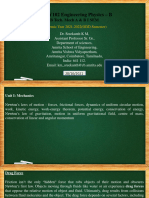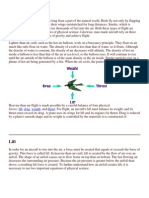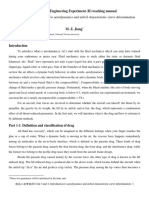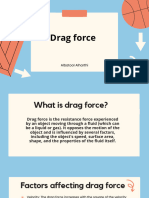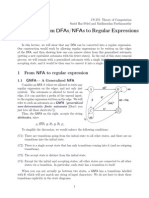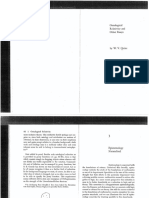Air Friction
Air Friction
Uploaded by
Marjerie FondevillaCopyright:
Available Formats
Air Friction
Air Friction
Uploaded by
Marjerie FondevillaCopyright
Available Formats
Share this document
Did you find this document useful?
Is this content inappropriate?
Copyright:
Available Formats
Air Friction
Air Friction
Uploaded by
Marjerie FondevillaCopyright:
Available Formats
Air Friction Air friction, or air drag, is an example of fluid friction.
Unlike the standard model of surface friction, such friction forces are velocity dependent. The velocity dependence may be very complicated, and only special cases can be treated analytically. http://hyperphysics.phy-astr.gsu.edu/hbase/airfri.html Air friction is simply resistance. This friction is created when a mass moves against a stable force like air, and is the measure of force needed to allow movement. For an easy visual, try pushing a cube or a triangle through water. You will understand the principal of streaming as the means to minimize that friction affect. When objects move on land, air particles are pushed away. This means more opposing forces against the moving object (in this case car and bicycles), reducing its speed, making it stop more quickly. http://wiki.answers.com/Q/How_air_friction_affect_motion_of_object_like_car_and_bicy cle Air friction is due to the object moving through the air having to move molecules of air aside. The larger the object the more air has to be moved aside and so the larger the air friction. Even surfaces parallel to the direction of motion of the object generate friction since molecules of air collide with the surface and are so pushed in the forward direction by the collision. By Newton's Second Law (Action and Reaction), they push back on the object, thereby generating more air friction. http://www.newton.dep.anl.gov/askasci/eng99/eng99362.htm
The air resistance that an object encounters is proportional to its cross-sectional area and to its velocity. Notice, that like friction, air resistance opposes motion. That is, if the object is rising through the air, air resistance acts downward; if it is falling, air resistance acts upwards. Notice that in the accompanying diagram, that the air resistance vectors vary in length. This signifies that its magnitude changes as the projectile's velocity changes. The air resistance, or drag force, is generally expressed as AR = Fdrag = kvn where k and n are constants that depend on the geometry of the object and the medium through which it is moving. When terminal speed is reached, net F = 0 AR + mg = 0 -kvn + mg = 0 -kvn = -mg kvn = mg v = (mg/k)1/n Obviously, the larger the values of k and n, the smaller the object's terminal speed. http://dev.physicslab.org/Document.aspx?doctype=3&filename=Dynamics_AirResistanc e.xml
Size and shape are the two factors that affect air resistance. Air resistance works with surface area, so the more surface area, the more air resistance. Think about when you drop two pieces of paper: one crumpled and one flat. The crumpled one falls faster because there is less air resistance acting on the paper. Air resistance pushes up while gravity pushes down. This is true for objects falling straight down. If the object was falling left or right, then air resistance would be opposite. If both gravity and air resistance pulled down, then air resistance wouldn't be air resistance! Air resistance is the opposite of gravity for an object falling down. It pushes up while gravity pushes down. http://www.funtrivia.com/en/subtopics/Air-Resistance-Its-All-Around-You-225326.html
You might also like
- Activating Skills For Listening 2 TranscriptsDocument32 pagesActivating Skills For Listening 2 TranscriptswellroundedfeidafuNo ratings yet
- MarksDocument31 pagesMarksCatalin BanuNo ratings yet
- Free Fall Experiment DiscussionDocument5 pagesFree Fall Experiment DiscussionAnonymous iJOQiAIvPT40% (5)
- GMW3232 PDFDocument15 pagesGMW3232 PDFIvan Dario Oyola RaveloNo ratings yet
- I.M. Young 5 Faces of OppressionDocument10 pagesI.M. Young 5 Faces of OppressionElleNo ratings yet
- Organic Lab 1 Final Exam ReviewDocument3 pagesOrganic Lab 1 Final Exam ReviewDanny Rosenberg100% (1)
- Aerodynamic Lab Report 1Document9 pagesAerodynamic Lab Report 1Mohamed Ahmed Elias0% (2)
- Air ResistanceDocument2 pagesAir Resistanceleevinas56No ratings yet
- Aerodynamics Thesis IdeasDocument6 pagesAerodynamics Thesis Ideasmelissadaehnmadison100% (2)
- Unit 1 Notes Aircraft Stability and Control NotesDocument18 pagesUnit 1 Notes Aircraft Stability and Control NotesMatthew RhoneyNo ratings yet
- 8.2 Aerodynamics 8.2.1: Airflow Around A BodyDocument6 pages8.2 Aerodynamics 8.2.1: Airflow Around A BodyNayem Hashan NayemNo ratings yet
- Acceleration Due To GravityDocument14 pagesAcceleration Due To GravityryanjamespmoralesNo ratings yet
- 009 Lect 8 Un02Document18 pages009 Lect 8 Un02Paidamoyo MlamboNo ratings yet
- Types of Drag On AircraftDocument20 pagesTypes of Drag On AircraftPramod DhaigudeNo ratings yet
- Parasitic DragDocument4 pagesParasitic DragsarfraazNo ratings yet
- Term Paper On AerodynamicsDocument6 pagesTerm Paper On Aerodynamicsafmzxpqoizljqo100% (1)
- 6 4 Drag Force and Terminal SpeedDocument12 pages6 4 Drag Force and Terminal Speedgenetamane6No ratings yet
- l7 Unit I MehanicsDocument15 pagesl7 Unit I MehanicsSivabharathi SivaNo ratings yet
- Physics - RevisionDocument9 pagesPhysics - RevisionLina ZuaiterNo ratings yet
- Safari - Jan 2, 2024 at 11:22 PMDocument1 pageSafari - Jan 2, 2024 at 11:22 PMsyansyncNo ratings yet
- CLASS 3bDocument3 pagesCLASS 3bmilesstuart209No ratings yet
- Drag ForceDocument9 pagesDrag ForceImran BahaNo ratings yet
- 04-Topic 3 ActivityDocument6 pages04-Topic 3 ActivityKarl Radison AbreaNo ratings yet
- What Is AerodynamicsDocument13 pagesWhat Is Aerodynamicsvishnu2427gehlotNo ratings yet
- What Is Drag in PhysicsDocument7 pagesWhat Is Drag in PhysicssureshNo ratings yet
- Aerodynamics Dissertation IdeasDocument8 pagesAerodynamics Dissertation IdeasBuyCollegePapersCanada100% (1)
- Activity 4 - Drag MeasurementDocument3 pagesActivity 4 - Drag MeasurementKhasmirNo ratings yet
- Theory of Flight: Lift Drag Weight ThrustDocument4 pagesTheory of Flight: Lift Drag Weight ThrustjpparceoNo ratings yet
- Foil (Fluid Mechanics)Document3 pagesFoil (Fluid Mechanics)bogdanNo ratings yet
- Theory Principles of FlightDocument128 pagesTheory Principles of Flightruzimahammadovamirbek1307No ratings yet
- Aero LabDocument17 pagesAero LabOlabode George BrownNo ratings yet
- Theory of Flight: Lift Drag Weight ThrustDocument8 pagesTheory of Flight: Lift Drag Weight ThrustJames Leonard Marquez BautistaNo ratings yet
- Flowseperation KumsalDeniz 2527521Document2 pagesFlowseperation KumsalDeniz 2527521Kumsal DenizNo ratings yet
- Mod 2 Book 3 PhysicsDocument42 pagesMod 2 Book 3 Physicsranjit prasadNo ratings yet
- Terminal VelocityDocument4 pagesTerminal VelocityZack AzharNo ratings yet
- Chapter 2-1-1-1Document14 pagesChapter 2-1-1-1Täð Œvê MîðNo ratings yet
- Drag ForcesDocument10 pagesDrag ForcesFahadNo ratings yet
- Gravity Drag Net Force Acceleration BuoyancyDocument2 pagesGravity Drag Net Force Acceleration Buoyancyjoepnko123No ratings yet
- C 01 Projectile MotionDocument26 pagesC 01 Projectile MotionSrinidhi sivaNo ratings yet
- Basic AerodynamicsDocument4 pagesBasic Aerodynamicsryanmcaffry6No ratings yet
- Basic Aerodynamics ProjectDocument6 pagesBasic Aerodynamics Projectryanmcaffry6No ratings yet
- Effects of Surface Roughness On Aerodyna PDFDocument15 pagesEffects of Surface Roughness On Aerodyna PDFWalter MarinhoNo ratings yet
- Chapter 3. Drag Force and Its Coefficient - noPW PDFDocument5 pagesChapter 3. Drag Force and Its Coefficient - noPW PDFashoku2No ratings yet
- Shock Pressure LossDocument5 pagesShock Pressure LossMahjabin NadiaNo ratings yet
- Peiran Ding and Arjaan Buijk - Simulation of Under Water Explosion Using MSC - DytranDocument9 pagesPeiran Ding and Arjaan Buijk - Simulation of Under Water Explosion Using MSC - DytranMallamaxNo ratings yet
- AeronauticalEngineering AerodynamicsDocument4 pagesAeronauticalEngineering AerodynamicskanscseNo ratings yet
- CH 3-Forces and MotionDocument2 pagesCH 3-Forces and MotionhasanNo ratings yet
- Chapter 11 CengalDocument65 pagesChapter 11 CengalDaniel MorganNo ratings yet
- Shape and Flow: Drag (Physics)Document9 pagesShape and Flow: Drag (Physics)Koral ToptopNo ratings yet
- Drag Coefficient ReportDocument13 pagesDrag Coefficient ReportMuhamad Aiman0% (1)
- Physics Project Lift and DragDocument12 pagesPhysics Project Lift and Dragapi-449771724No ratings yet
- Chapter 2Document33 pagesChapter 2Täð Œvê MîðNo ratings yet
- Unit 3 and 4 - Introduction To Aerodynamics and Airfoil Characteristic Curve DeterminationDocument27 pagesUnit 3 and 4 - Introduction To Aerodynamics and Airfoil Characteristic Curve Determinationxie garbageNo ratings yet
- Coefficient of RestitutionDocument13 pagesCoefficient of RestitutionDivina Mercedes FernandoNo ratings yet
- Examples of Drag: Shape and Flow Form Drag Skin FrictionDocument8 pagesExamples of Drag: Shape and Flow Form Drag Skin FrictionDeepank SachdevNo ratings yet
- Air Drag and Terminal Velocity NotesDocument3 pagesAir Drag and Terminal Velocity NotesSaumya SinhaNo ratings yet
- Physics Term1Document7 pagesPhysics Term1albatoolsmaNo ratings yet
- Drag (Physics)Document13 pagesDrag (Physics)povib72230No ratings yet
- Air Cadet Publication: FlightDocument62 pagesAir Cadet Publication: FlightMarcus Drago100% (1)
- STUFFDocument13 pagesSTUFFAyesha SealeyNo ratings yet
- CFD Analysis of An AerofoilDocument5 pagesCFD Analysis of An AerofoilSwapoor ChakravarthyNo ratings yet
- Projectile Motioncaused byDocument7 pagesProjectile Motioncaused byDarryll RamosNo ratings yet
- Model aeroplanes: The building of model monoplanes, biplanes, etc., together with a chapter on building a model airshipFrom EverandModel aeroplanes: The building of model monoplanes, biplanes, etc., together with a chapter on building a model airshipNo ratings yet
- 211 Css Flexbox SlidesDocument6 pages211 Css Flexbox SlidesabbasiashNo ratings yet
- Amurao vs. VillalobosDocument3 pagesAmurao vs. VillalobosMae NavarraNo ratings yet
- Business Correspondence - Module Number 2-The Parts of A Business Letter Name: - Date Submitted: - InstructorDocument5 pagesBusiness Correspondence - Module Number 2-The Parts of A Business Letter Name: - Date Submitted: - InstructorElle Bee50% (2)
- Nfa To GrammarDocument8 pagesNfa To GrammarRaducanu TheodorNo ratings yet
- Plato: - Western Political ThinkerDocument42 pagesPlato: - Western Political ThinkerRamsha HafeezNo ratings yet
- YTD Based On Fiscal Year Period Without Cmod CodeDocument28 pagesYTD Based On Fiscal Year Period Without Cmod CodeRaviNo ratings yet
- HAS 4116 - L4 Employment RelationshipDocument4 pagesHAS 4116 - L4 Employment Relationship[4R13] WONG KA HEI-黃珈熹No ratings yet
- Submission of A Project Is A Part of The Requirement For The CoursedcaDocument16 pagesSubmission of A Project Is A Part of The Requirement For The CoursedcaSamir AhmedNo ratings yet
- BBA FIB Syllabus 2023Document131 pagesBBA FIB Syllabus 2023Mayank kumarNo ratings yet
- Sem 3 - Public Speaking Study MaterialDocument12 pagesSem 3 - Public Speaking Study MaterialJhanvikuvarba SolankiNo ratings yet
- I.Choose A, B, C or D To Complete The Sentences (5.0 PTS)Document3 pagesI.Choose A, B, C or D To Complete The Sentences (5.0 PTS)Nhóc Hok BuồnNo ratings yet
- Examen Semillero de Investigación en Genética ClínicaDocument9 pagesExamen Semillero de Investigación en Genética ClínicaLauraCamilaMorenoNuñezNo ratings yet
- Desu NotoDocument9 pagesDesu NotoAiza OronceNo ratings yet
- Quine 1969Document13 pagesQuine 1969Hans OrangenbaumNo ratings yet
- An Untruthful ElephantDocument4 pagesAn Untruthful ElephantRifky Fajrin HasrinNo ratings yet
- Health and Health Behaviour Among Young PeopleDocument148 pagesHealth and Health Behaviour Among Young PeopleAnakAgunk AriNo ratings yet
- 1999 Health Effects of Stainless SteelsDocument154 pages1999 Health Effects of Stainless SteelsDionysius Septian Cahya OlivianoNo ratings yet
- Application of Behaviorist, Cognitivist, Constructivist and Humanist PrincipleDocument12 pagesApplication of Behaviorist, Cognitivist, Constructivist and Humanist PrincipleJulius Lita100% (3)
- Stephen Frederic Dale, Steppe Humanism - The Autobiographical Writings of Zahir Al-Din Muhammad BaburDocument22 pagesStephen Frederic Dale, Steppe Humanism - The Autobiographical Writings of Zahir Al-Din Muhammad Baburmario rossiNo ratings yet
- SHAYEARI - DUTTAOut of Business, Text2021-06-16out of Business, R.K. NarayanDocument4 pagesSHAYEARI - DUTTAOut of Business, Text2021-06-16out of Business, R.K. Narayanksucheta013100% (1)
- Our Lady of FatimaDocument22 pagesOur Lady of FatimaAnica Suzi JevickiNo ratings yet
- E-Tray ResultsDocument7 pagesE-Tray ResultsHMP SpamsNo ratings yet
- Business Ethics and EtiquetteDocument15 pagesBusiness Ethics and EtiquetteLya Hellen100% (1)
- Survey of Special Penal LawsDocument91 pagesSurvey of Special Penal LawsAldrin CrutoNo ratings yet
- Paragraphs: What Is A Paragraph?Document5 pagesParagraphs: What Is A Paragraph?Cristian ErazoNo ratings yet

















